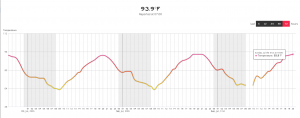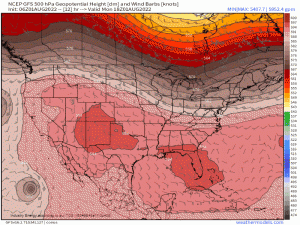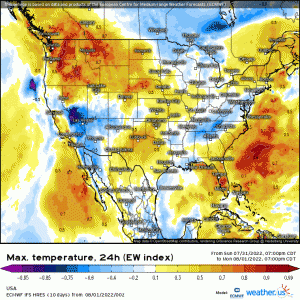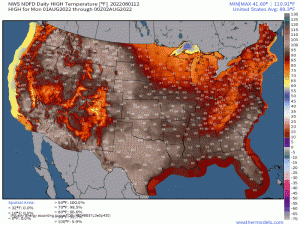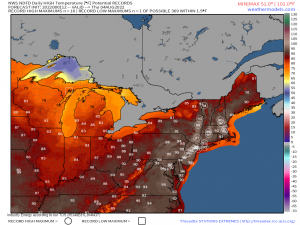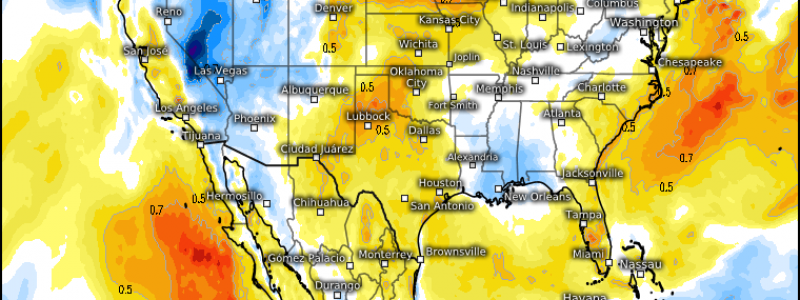
Heat On The Move
How about the recent heat in the Pacific Northwest?
While it didn’t manage the same intensity as the June 2021 heatwave, it made up for it in sheer duration. Some locations spent, or will spend, a week in an official heatwave.
Seattle, WA set a new record. It wasn’t an all-time record high, but rather related to duration.
The observations at weather.us only display the last 72 hours, however, Seattle recorded 6 consecutive days of daily maximum temperatures in the 90s. This beats the previous record of 5 consecutive days at/above 90 degrees set in 1941, 1981, and 2015. So, as I stated earlier, while the heat may not have been the most extreme temperature-wise, it was extreme in duration.
And now it’s on the move.
The ridge responsible for the heat begins to shift eastward today before amplifying over the mid and eastern US toward the end of the week.
So what does this mean in terms of temperatures?
Well, we can refer to the Extreme Weather Index which, if you’ll recall, is a tool that can highlight the potential for highly unusual weather. In this case, it highlights maximum temperatures well above or below what you’d typically expect. Once values begin approaching the 0.9-1 range, it indicates great confidence in maximum temps being much warmer than usual.
So what we’re expecting is a core of very warm temperatures slowly moving east before back-building into the Central US once again.
Like this, if you need a visual.
While it appears as if everyone will get a taste of the heat, it really lingers the most in the Central US. In fact, temperatures in the triple digits all the way up to the Canadian border are possible on a few days, including today.
Heat Advisories and Excessive Heat Warnings are posted for the Interior Northwest for today and will no doubt be expanded eastward as the week wears on.
While today’s heat could be widespread record-setting for the interior Northwest, we’ll need to watch the Northeast on Thursday for record heat.
Upper 90s in the major metro areas will not only break records, but make the population rather miserable as well.
For those wondering why 90s and low-end 100s are such a big deal, remember that many homes in these regions along the northern fringes of the country generally don’t have central air. It isn’t usually needed. Prolonged heat like we experience every summer in the southern US isn’t terribly common for the northern US. Or, at least, it wasn’t until more recent years.
I grew up in northeast Pennsylvania in the 90s. Summers were cool and often rainy. “Perfect” pool days were few and far between. Most of the time, we settled for swimming when it was barely 75 degrees outside and the pool water was the temperature of a newly defrosted glacier.
But the years have worn on and the climate has begun to modify, bringing much longer, hotter periods. And much warmer nights, as well. Unfortunately, many homes in this region were built long ago, before central air. Two of the homes I lived in were built in 1901 and 1930. Now, of course, there is new construction and some have added air, but many are still without.
The point of that little side story was that heat is a bigger deal to these northern communities that aren’t always prepared with ways to stay cool. Many can’t just turn on the AC and stay inside. So it’s important to discuss the heat before it begins and allow people time to make plans to deal with it.
If you’ve made it this far, thanks for reading through my story time. Consider this post a heads-up to those in northern communities without much AC that you need to prepare for the heat. This goes especially for those in the Central US that will see more prolonged heat.
Here is a link to heat safety tips, if anyone is in need: https://www.weather.gov/safety/heat-during
Check back here and on Twitter this week as we’ll keep you updated.
